Содержание
- 2. Outline 1.Composite sentence 1.1. Compound sentence 1.2. Complex sentence 2.Compound and complex sentences in the transformational
- 3. M. Y. Blokh: “The composite sentence, as different from the simple sentence, is formed by two
- 4. The means of combining clauses in polypredicative sentences Syndetic Asyndetic (conjunctional) (non- conjunctional) Yesterday I bought
- 5. Composite sentences display two principal types of construction Subordination (inequality) Coordination (equal rank)
- 6. Composite sentence Compound: Compound Semi-compound Complex: Complex Semi- complex
- 7. Compound sentence - a composite sentence derived from two or more base sentences connected on the
- 8. Semi-compound sentence is a semi-composite sentence built up on the principle of coordination. The semi- compound
- 9. Complex sentence contains one or more subordinate clauses. Usually the subordinate clauses are connected by means
- 10. Semi-complex sentence is a semi-composite sentence built up on the principle of subordination. It is derived
- 11. Composite Compound: Copulative coordination Disjunctive coordination Adversative coordination Causative – consecutive coordination Complex: Types of subordinate
- 12. Transformational grammar The main idea of the transformational grammar is that any language contains a rather
- 13. The list of kernel sentences
- 14. Three types of transformations: Transformations in simple sentences Two-base transformations (compound, semi-compound, complex, semi-complex sentences) Transformation
- 15. Transformations in simple sentences: The car works S S The car does work. Does the car
- 16. Transformations of nominalization The car works. S NP The work of the car. The car’s work.
- 17. Two-base transformations The car works. S1 + S2 S3 The car works and hums. When the
- 18. Transformations in compound sentences S1 +S2 Compound S3 Two kernel sentences are joined together into a
- 19. Transformations in semi-compound sentences S1+S2 Semi-compound S3 1. Overlapping round the identical NP-subject 1. I must
- 20. Transformations in complex sentences S1+S2 Complex S3 Three types of subordinators: N-subordinators (or conjunctives), A-subordinators (or
- 21. 1. Complex Sentences with N-Clauses The N-subordinators (conjunctives): what (whatever), who (whoever), when (whenever), where (wherever),
- 22. Transformations in semi-complex sentences S1+S2 Semi-complex S3 Two ways of connecting sentences: changing the finite verb
- 23. Subject sharing We waited. We were breathless. We waited breathless. Object sharing I saw him. I
- 24. The list of sources 1. Александрова О.В., Комова Т.А. Современный английский язык. Морфология и синтаксис. –
- 25. 1.Complex sentence is built on the principle of … a) subordination b) coordination c) other 2.The
- 27. Скачать презентацию

















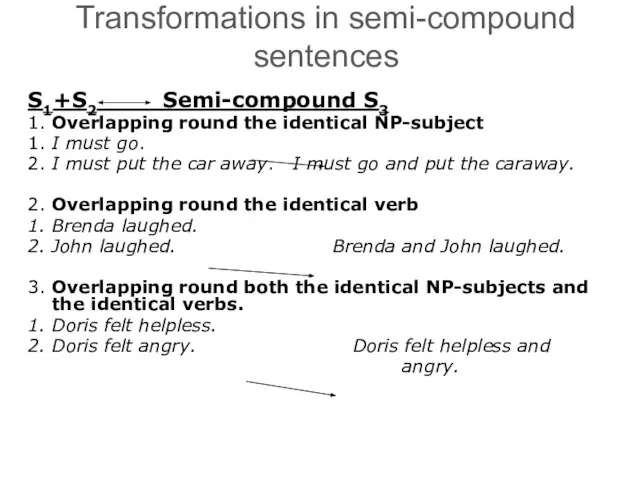

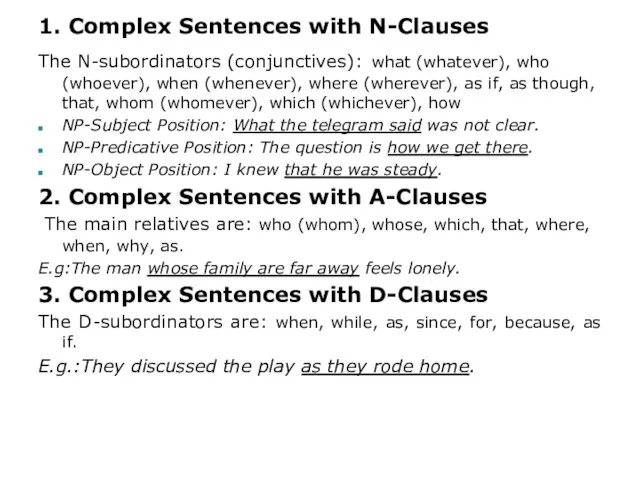
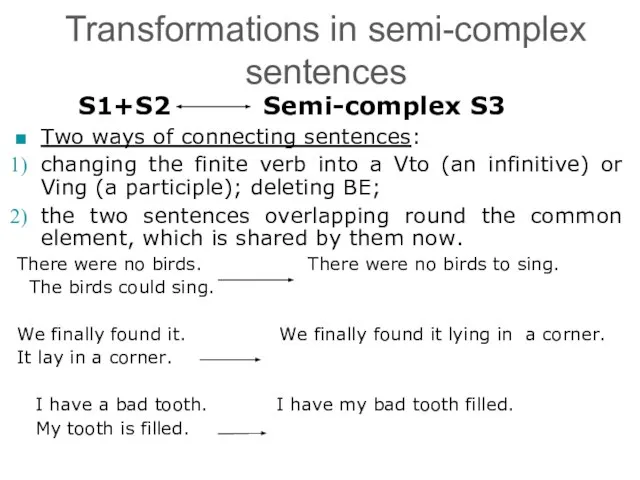

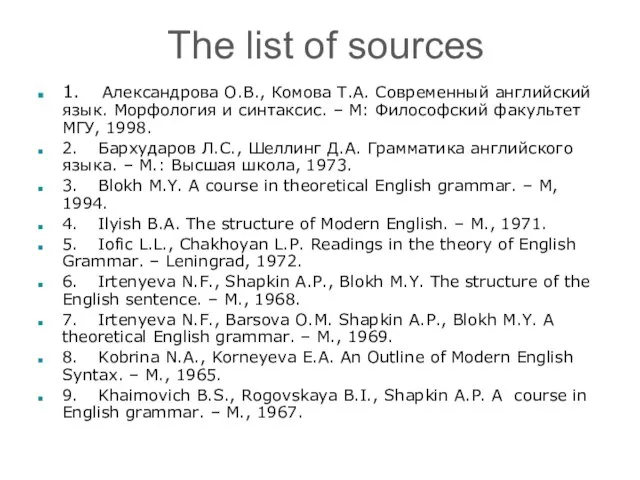
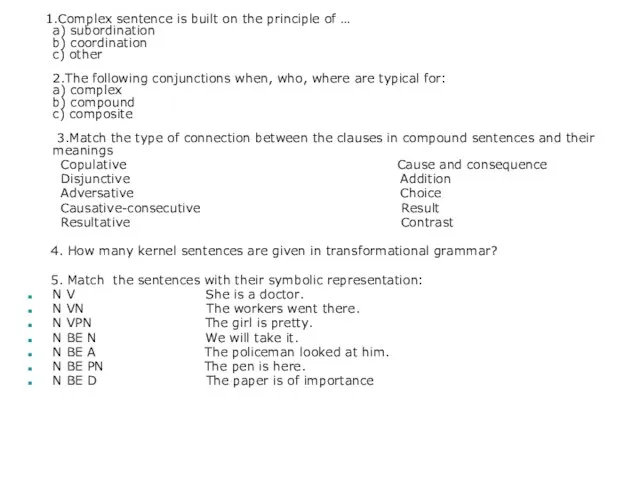
 Презентация к уроку английского языка "A magic island" - скачать бесплатно
Презентация к уроку английского языка "A magic island" - скачать бесплатно I do know both of you! — Я точно знаю вас обоих!
I do know both of you! — Я точно знаю вас обоих! Evolution of Youth Groups in Russia Sokolova Tatyana 10 class
Evolution of Youth Groups in Russia Sokolova Tatyana 10 class  Keep out of
Keep out of Lena River
Lena River  Grammar. Question Words
Grammar. Question Words Презентация к уроку английского языка "Happy easter" - скачать
Презентация к уроку английского языка "Happy easter" - скачать  Name. Start
Name. Start Her Majesty Queen Elizabeth II (к 90-летию со дня рождения) Автор презентации: Антоненко Ирина Григорьевна, учитель английского языка М
Her Majesty Queen Elizabeth II (к 90-летию со дня рождения) Автор презентации: Антоненко Ирина Григорьевна, учитель английского языка М Jobs and places. The city and the country. Dwellings
Jobs and places. The city and the country. Dwellings Household chores
Household chores The usage of the Phonetic stylistic devices in Kazakh and English languages
The usage of the Phonetic stylistic devices in Kazakh and English languages Грамматическая сказка Остров сокровищ
Грамматическая сказка Остров сокровищ Theodore Dreiser
Theodore Dreiser Collective noun. Game
Collective noun. Game Презентация подготовлена учителем английского языка МКОУ «СОШ№15» п.Рефтинский Авдеевой Татьяной Викторовной
Презентация подготовлена учителем английского языка МКОУ «СОШ№15» п.Рефтинский Авдеевой Татьяной Викторовной  УКАЗАТЕЛЬНЫЕ МЕСТОИМЕНИЯ Учитель английского языка ГБОУ школа № 83 г. Санкт-Петербург Корчагина Виктория Евгеньевна
УКАЗАТЕЛЬНЫЕ МЕСТОИМЕНИЯ Учитель английского языка ГБОУ школа № 83 г. Санкт-Петербург Корчагина Виктория Евгеньевна The English language In my daily life
The English language In my daily life IELTS: Last Moment Tips
IELTS: Last Moment Tips Презентация к уроку английского языка "The problems of youth" - скачать
Презентация к уроку английского языка "The problems of youth" - скачать  Let's learn some prefixes
Let's learn some prefixes Animals. Внеклассное мероприятие для 4 класса
Animals. Внеклассное мероприятие для 4 класса ОГЭ - Электронное письмо
ОГЭ - Электронное письмо Ancient Greec-Roman philosophy. (Lecture 3)
Ancient Greec-Roman philosophy. (Lecture 3) Happy New Year! Учитель английского языка МОУ СОШ № 10 г. Жуковский Куликова Анастасия Александровна
Happy New Year! Учитель английского языка МОУ СОШ № 10 г. Жуковский Куликова Анастасия Александровна  Harriet Beecher Stowe (1811-1896)
Harriet Beecher Stowe (1811-1896)  TENSES IN ENGLISH Подготовила преподаватель английского языка ГУО «Пинковичской средней школы им.Якуба коласа» Пинского района, брес
TENSES IN ENGLISH Подготовила преподаватель английского языка ГУО «Пинковичской средней школы им.Якуба коласа» Пинского района, брес Phrasal verbs
Phrasal verbs